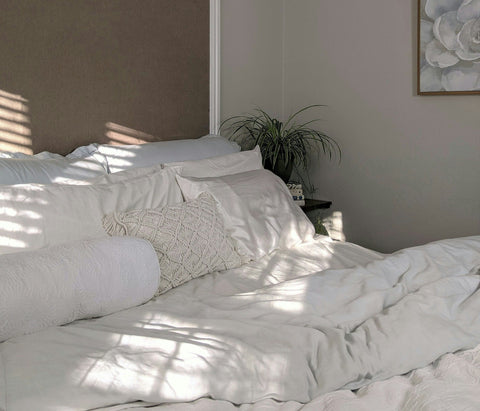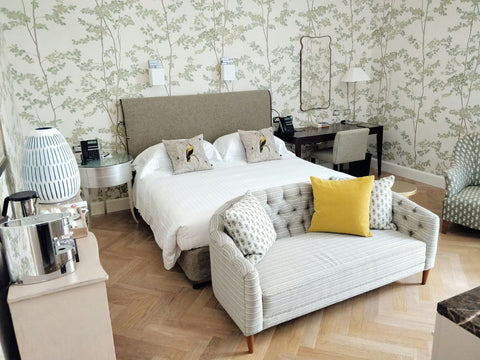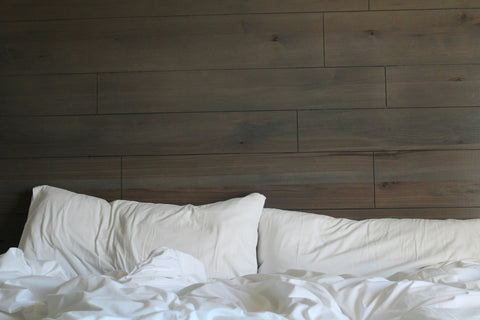
Waking up with a stuffy nose, itchy eyes, or a scratchy throat is no way to start your day. If you suffer from allergies, you know these pesky symptoms can be triggered by allergens in your home, especially in your bedding. Dust mites, mold, and pet dander are some common culprits that can make your life miserable. The best comforter for allergies can help to minimize or even eliminate these nasty triggers so that you can enjoy uninterrupted, allergen-free sleep every night with a soft, breathable comforter that keeps dust, dander, and irritants away—all year long. The Best Duvet Insert can make a huge difference. This article will help you choose the right comforter for your allergy needs so you can breathe easier and get the restful sleep you deserve.
Cloud-like fluffy duvets by Yumerest are a valuable tool for achieving goals. These soft, breathable comforters are designed to support healthy sleep by resisting allergens, so you can enjoy a cozy, restful night without the worries of waking up to allergy symptoms.
How Do Anti-Allergy Comforters Work?

Night-time allergies can be seasonal or year-round and are typically caused by allergic rhinitis (hay fever). Many people think pollen is the only cause of allergic rhinitis, but several other things, like:
-
Pet dander
-
Dust mites
-
Mold
It can also be the cause. Dust mites and mold are the most common causes of night-time allergies because they thrive in mattresses and bedding.
Dust Mites
Dust mites love bedding and mattresses because they provide a warm, humid environment with easy access to food (dead skin cells). Unprotected mattresses can harbor up to two million dust mites, and your bedding can become infested in less than 90 days.
Fungal Spores
Sometimes, mattresses or bedding grow mold, which releases spores while you sleep and triggers nighttime allergies. Mold spores are almost always in the air, but humid environments encourage their growth. Bedding that isn’t breathable can create excess moisture, contributing to this environment.
The Symptoms of Night-time Allergies
Night-time allergies cause symptoms that can be so aggravating they prevent sleep. Research shows that over 90% of people suffering from night-time allergies have difficulty sleeping. The symptoms of night-time allergies include
-
Sneezing
-
Itchy nose, throat, or eyes
-
Cough
-
Runny nose
-
Nasal congestion
-
Postnasal drip
-
Rash or itchy skin
How Anti-Allergy Comforters Work
Hypoallergenic comforters prevent mold growth and keep dust mites from freely moving around. Depending on the design of the anti-allergy comforters, they can reduce allergens in one of two ways:
Traps Allergens
Some allergy-free comforters trap fungus spores and dust mites in the bedding so they cannot disperse and cause allergies. Generally speaking, synthetic hypoallergenic comforters work this way due to the dense fabric weave.
Repels Allergens
The best hypoallergenic allergy comforters are made from natural materials that can repel fungal spores and dust mites. These materials keep them away from your bed rather than keeping them in. Wool is the best material for anti-allergy comforters because it provides a calm, dry environment that makes it difficult for allergens to survive.
Related Reading
- Best Fluffy Comforter
- How to Choose a Down Comforter
- Best Down Alternative Comforter
- Best Goose Down Comforter
How to Choose the Best Comforter for Allergies

When selecting a comforter for allergies, the materials are first considered. Comforters are made of materials: the fill type and the shell or outer layer. Understanding how these components affect allergies will help you make a wise choice.
Fill Type: Down, Wool, or Synthetic?
Down and wool are the best options for allergy sufferers regarding the fill type.
Debunking Myths About Down Comforters and Allergies
Down and feather comforters are NOT allergenic. One of the most common misconceptions about bedding is that anything made from down or feathers is a no-go for people with allergies. That’s not true at all.
Some people have down or feather allergies, but these are rare. Most people who experience allergy symptoms when they use natural down bedding are reacting to dust mites in the fibers. These dust mites typically come from inside your home and can settle on any type of comfort, not just a down comforter. So if you love the:
-
Comfort
-
Eco-friendliness
-
Cooling power of a down comforter
Go ahead and get it. Most companies selling these natural comforters thoroughly clean the feathers inside to remove dust mites and allergens. Despite what you may have heard, down and feather bedding is not allergenic for most people. You can safely sleep under a down comforter if you have allergies.
Why Wool Comforters are a Great Choice for Allergy Sufferers
Wool comforters are also great for allergies. Wool is one of the best comfort materials for people with allergies. It is naturally resistant to dust mites because it’s often too dry for them to thrive.
Wool does a great job absorbing sweat from your skin and quickly releasing it into the air instead of holding onto it. That means it’s also unlikely to harbor mold. As a bonus, a wool comforter also has excellent temperature regulation, keeping you cool when it’s hot and conserving heat when it’s chilly. A few people can be allergic to wool and should not get a wool comforter. But wool allergy is rare. Be careful with microfiber/down alternative comforters.
The Allergy Risks of Microfiber Comforters
Microfiber comforters are cheaper alternatives to natural down comforters. Microfiber, a synthetic material, is naturally hypoallergenic.
That is, it is unlikely to cause any allergies by itself. But just like down and other materials, dust mites can settle on a down alternative duvet. A synthetic comfort can hold more dust mites and other allergens like mold because of its lower breathability.
Choosing the Right Comforter for Allergy Prevention
The problem with microfiber comforters is that they trap heat and moisture, creating the perfect conditions for mold and dust mites to thrive. Things get worse if you drape the comforter in a microfiber/polyester cover that traps even more heat and moisture.
If you have allergies, either opt for a natural comforter made from down or wool, or pick a well-made down alternative comforter with good breathability. Combine it with a breathable cotton, bamboo, silk, or linen duvet cover.
The Importance of Washability
The best way to protect yourself against allergens in the comforter is to keep it clean and hygienic. Many people don’t wash their comforters as often as they should. Over time, they accumulate allergens like:
-
Dust
-
Dust mites
-
Pet hair
-
Pollen
-
Mold spores
Washing a comforter in hot water is usually enough to eliminate most allergens. But follow the care instructions, especially if you have a wool or down comforter, as these are delicate.
Why You Need a Duvet Cover
In addition to washing your comforter regularly, get a duvet cover for it. A duvet cover is the best defense against allergies in your comforter. It keeps allergens out and keeps the comforter cleaner, meaning you don't have to wash it as often. This is especially helpful for delicate comforters that shouldn’t be washed too much.
Shell Fabric Matters
The shell fabric of a comforter is its outer layer and one of the first lines of defense against allergens. The best shell fabric for allergy sufferers is air-permeable, tightly woven, and hypoallergenic.
Cotton, for example, is an excellent choice because it is naturally breathable. A tightly woven cotton fabric can also be a barrier to dust mites, pet dander, and other common allergens, which is important for those with respiratory issues or skin sensitivities.
The Importance of a Quality Shell and Regular Washing
A quality shell reduces the chance of reactions and ensures that the comforter withstands regular washing. Frequent laundering is essential for allergy sufferers, as it removes accumulated allergens and maintains a clean sleeping environment.
These rules also apply to bedsheets, which should be washed weekly. Our queen fitted sheet is made from pure cotton sateen, pairing nicely with comforters and keeping allergies at bay.
Weight & Loft: What’s Right for You?
Allergy sufferers should consider a comforter that provides adequate warmth without being overly heavy, as excessive weight can exacerbate discomfort and disrupted sleep. Our research indicates that loft refers to the thickness and fluffiness of a comforter, which determines its insulation and warmth.
A higher loft usually means more warmth, ideal for colder climates or winter months. However, it’s also essential for allergy sufferers to balance loft with breathability to prevent overheating and sweating, which can aggravate allergies and attract dust mites.
Construction: Look for Box Stitching
The construction of a comforter refers to how it’s made and how the fill is secured within the shell. For allergy sufferers, this is crucial as it can affect the distribution of fill, the potential for allergen accumulation, and the overall longevity and effectiveness of the comforter.
Box stitching is a popular construction method in which the fill is sectioned into boxes to prevent shifting and clumping. This ensures an even distribution of warmth and prevents cold spots, creating a more comfortable sleeping environment.
The Role of Construction in Comforter Durability and Allergy Prevention
Tightly sealed edges are essential for avoiding fill materials from escaping. Good construction also contributes to the comforter's durability and ease of care. Allergy sufferers benefit from a comforter that maintains its fill distribution even after multiple washes, as they will probably wash their comforters more often.
Related Reading
- Best Comforter Material for Hot Sleepers
- Best Duvet Cover Material
- Duvet Tog Guide
- Best Duvet for Night Sweats
10 Best Comforters for Allergies to Keep Dust Mites & Dander Away
1. Yumerest: Cloud-like Softness for Luxurious Sleep

Yumerest's PureFlow Duvet transforms your bedroom into a luxurious sanctuary. It envelops you in cloud-like softness with its exceptional 5kg filling that promotes more profound, more restorative sleep. This premium Canadian duvet stands apart from competitors like Happy Fluffy Cloud and Hush because it is ethically sourced north down.
It perfectly regulates temperature year-round. It’s ever too hot, just perfectly cozy. Crafted by expert artisans with techniques perfected since 1946, our duvets combine traditional craftsmanship with modern innovation for an unparalleled sleeping experience.
Complete Sanctuary
The PureFlow bundle, featuring our heavenly duvet, elegant cover, and calming sleep mist, creates a complete sleep sanctuary that helps busy professionals and parents finally achieve the rejuvenating rest they deserve. Get deep sleep every night with our cloud-like fluffy duvets.
2. Utopia Bedding Comforter Duvet Insert: User-Friendly Quality

With more than 70,000 reviews and a standout 4.7-star overall rating, you know the Utopia Bedding down-alternative comforter is fluffy, soft, warm, and breathable. However, the best part for people with allergies is the hypoallergenic barrier that protects against dust mites and mildew. It’s also machine-washable and made with quality features like box-stitching to keep the filling from shifting or clumping and materials that stand up to everyday wear.
3. Buffy Cloud Comforter: Eco-Friendly and Hypoallergenic

Buffy’s Cloud Comforter has a hypoallergenic filling and an eucalyptus cover that’s soft, silky, and breathable for hot sleepers or climates. Even better, the filling is made of 100% recycled materials, which is more eco-friendly than your standard comforter.
“I've had Buffy's Cloud Comforter for years and it is so comfortable to sleep under,” one Bustle editor said. “The eucalyptus fabric feels silky and soft to the touch, and the down-alternative filling is so fluffy, you'd never know it was made with recycled plastic.” It may be pricey, but this comforter has won over hundreds more fans who report it lives up to its name: It's like sleeping on a cloud.
4. Madison Park Down Alternative Blanket: Stylish and Functional

It’s technically a blanket rather than a comforter. Still, since it’s made with Scotchgard stain resistance and is easily machine washable, this Madison Park hypoallergenic blanket is a great way to add warmth to your bed without worrying about the duvet cover. Suppose you’re looking to add a bonus layer of warmth. It comes in 19 colors so it’s easy to decorate your room to suit your style. It’s backed by a 4.6-star overall rating after more than 6,000 reviews.
5. ClimaBalance All Season Comforter: The Best Cooling Comforter for Hot Sleepers

In addition to hypoallergenic materials, the ClimaBalance lightweight comforter might be the most technologically advanced cooling blanket you've ever owned. It uses adjustable mesh baffles, careful ventilation, and proven ClimaBalance technology to transport heat and humidity three times faster than your average comforter. That means your body temperature stays balanced and you stay calm and sweat-free all night.
6. Silk Camel Luxury Allergy-Free Comforter: Naturally Hypoallergenic Option

Wrapped in cotton and filled with actual long-strand mulberry silk, this Silk Camel comforter is an excellent source of relief for those with allergies. It’s naturally resistant to bugs, mites, mildew, and mold, and it’s super lightweight and cooling for hot sleepers or summer months.
7. Linenspa All-Season Comforter: Affordable and Attractive

This hypoallergenic blanket is designed to be gorgeous with or without a duvet cover. It's made with down-alternative filling that stays in place thanks to the box-stitching. If you prefer a duvet, you'll appreciate the piped edges and four corner tabs that help anchor your comforter cover. Either way, your bed will look pristine. Choose from 21 colors and styles in a range of sizes.
8. Modern City Quilt Set: Lightweight and Hypoallergenic

This microfiber quilt is hypoallergenic and comes with two matching pillow covers. The patterned design adds texture to your decor, and the multi-layered microfiber is lightweight but warm. You can choose from various colors and styles to complement your space.
9. Brooklinen, Down Alternative Hypoallergenic Comforter: Eco-Friendly and Award-Winning

Brooklinen’s eco-friendly, hypoallergenic comforter has won so many awards, we’ve lost count. All three weights are made with baffle box stitching, which (as the experts told us) is your best bet for both the comfort and longevity of your quilt.
10. Slumber, Cloud Lightweight Comforter: NASA Technology for Sleep

Considering this comforter's filling was made with technology tested by NASA, you know it’s gotta be good. The filling is made with Outlast phase change material, which absorbs excess body heat when you get hot and releases it back to you when you get cold (hence why it’s used in astronauts’ space suits). It sounds like magic, but it’s legit and will change how you sleep forever.
Get Deep Sleep Every Night with Our Cloud-like Soft Fluffy Duvets
Yumerest creates luxurious products that promote deeper sleep. The PureFlow Duvet transforms your bedroom into a sanctuary, enveloping you in cloud-like softness with its generous 5kg fill. This premium Canadian duvet stands apart from competitors like Happy Fluffy Cloud and Hush with its ethically sourced northern down that perfectly regulates temperature year-round, never too hot, and just perfectly cozy.
Crafted by expert artisans with techniques perfected since 1946, our duvets combine traditional craftsmanship with modern innovation for an unparalleled sleeping experience.
The PureFlow bundle, featuring our:
-
Heavenly duvet
-
Elegant cover
-
Calming sleep mist
Creates a complete sleep sanctuary that helps busy professionals and parents finally achieve the rejuvenating rest they deserve. Get deep sleep every night with our cloud-like soft fluffy duvets.







